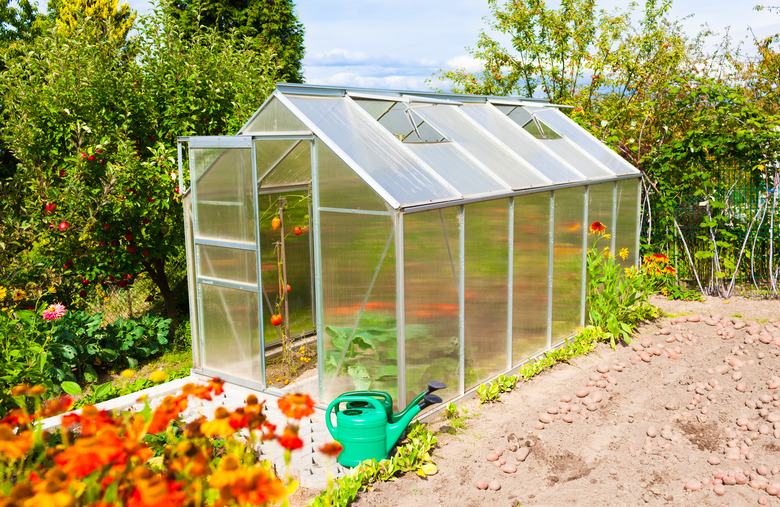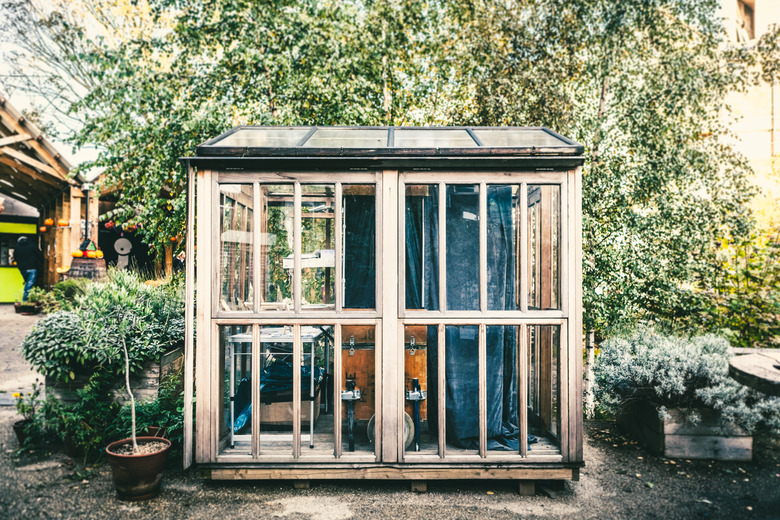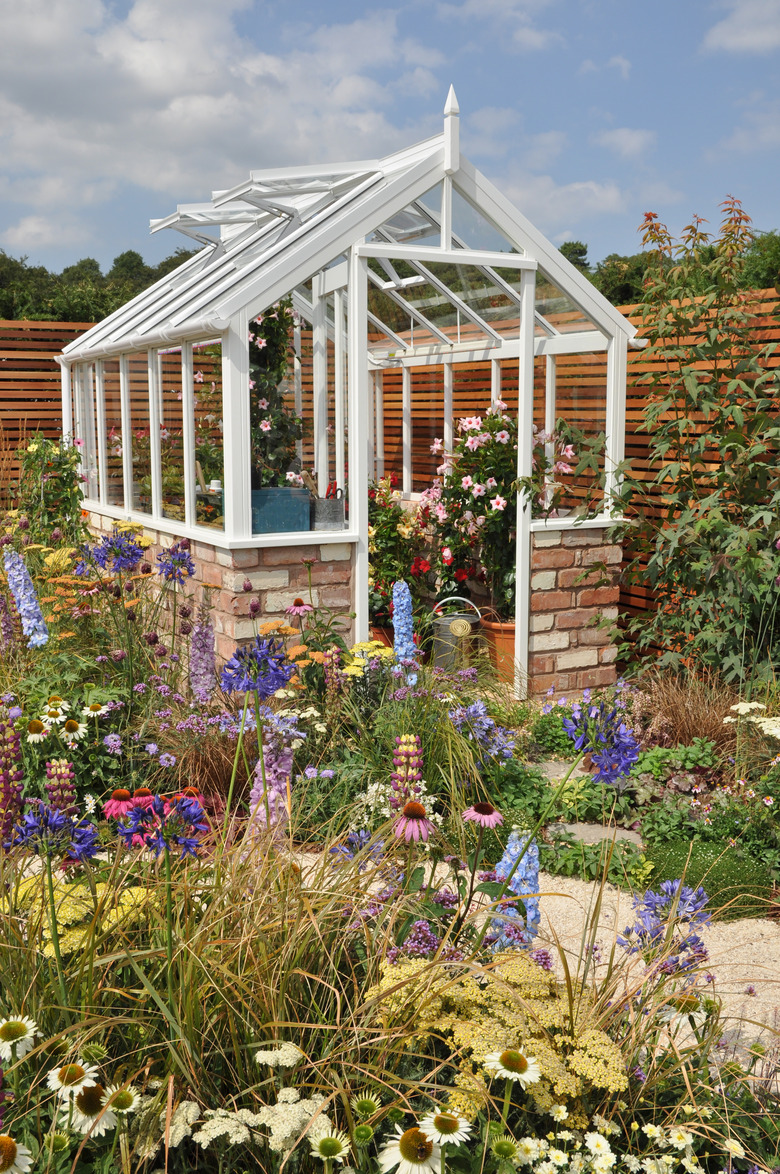How To Plan A DIY Greenhouse
We may receive a commission on purchases made from links.
There are many benefits to having your own DIY greenhouse, including extending your growing season for a vegetable garden and growing plants that aren't usually found in your area. It you want to have a successful DIY greenhouse, it will take some planning. There's a lot that goes into greenhouse plans, including what you want to grow, where you want to locate the greenhouse and how big of a structure you are seeking.
Other decisions to be made when you plan your greenhouse project include whether you want a portable greenhouse or a permanent structure. If you choose a permanent structure, not only will you need to determine the size of your DIY greenhouse but also the materials to be used for the framing, covering and flooring. Other considerations include whether or not you'll need a permit or if your municipality or homeowners' association has special requirements. Also, will your greenhouse require plumbing and electricity, and how will you get it there?
Budget, of course, will be key to all of your DIY greenhouse design ideas. The size of your budget can affect whether you design the Taj Mahal of greenhouses or go with a small, simple beginner greenhouse kit. It's helpful to do a little research on the different components that go into designing a greenhouse system along with the different building materials that can be used for the structure. Keep in mind that a greenhouse can be a large investment but can last a long time, so taking the time beforehand to plan it out will pay off in the long run.
Choose a Greenhouse Location
Choose a Greenhouse Location
If you have a small outdoor space or are otherwise pressed for room in your backyard, you might not have much choice about where you place your greenhouse. Whether your location options are numerous or few, you'll want to place your greenhouse in the best-possible area on your landscaping. That means a location that provides maximum exposure to sunlight for at least six hours per day.
The direction your greenhouse faces is important when considering maximum sunlight for your plants. For optimal sunlight, your homemade greenhouse should face south regardless of the season. If directly south is not possible, southeast is the next best choice. This will allow it to get morning sun, which is especially important because it can warm the plants after cool nights.
Other factors to consider when deciding on a greenhouse location include setting it on stable ground with adequate drainage as well as the distance from the house. Elevated ground is best or at least an area where there is no risk of irrigation or rainwater pooling or flooding.
A site that is close to the house is best when doing your greenhouse planning because not only are you more likely to use a greenhouse when it's close but it also makes it easier to provide the greenhouse with electricity and water. Also, setting a greenhouse near deciduous shade trees will provide shade from the intensely hot summer sun (particularly afternoon sun from the west) while allowing full sunlight during the winter months after the leaves fall from the trees.
Size of Your DIY Greenhouse
Size of Your DIY Greenhouse
There are many sites available online to help with all steps of greenhouse planning and designing, including greenhouse style and size. When considering size during your greenhouse design, think about how much space is needed for what you are planning to grow. Think to the future as well and leave a decent amount of room for expansion if possible. Many people, upon finding that their greenhouse is a success, decide that they'd like to have more room to grow more plants. Planning ahead for that extra space means less work when the time comes to expand.
There are several factors that will affect how much space your greenhouse will need, including the plants you plan to grow. Starting your plants as seeds or seedlings tends to require relatively little space, but that will change as they grow. Plan to have at least triple the area needed once the plants grow. The interior design of the greenhouse will also help determine the size needed when planning your greenhouse. For a larger structure, when working on your DIY greenhouse plans you might want to plan for walking space, shelves, benches, an irrigation or misting system and other extras, like hanging baskets.
The accessories you decide to use in your garden greenhouse will usually be determined by your needs and your budget. Walkways are important in a greenhouse, of course, because they allow you to observe and tend to your plants. A general rule of thumb is to use 40 percent of the floor area for walking space. In a larger greenhouse, it's also a good idea to keep benches and other working space 2 to 3 feet away from the edges of the greenhouse. This will make it easier to do any necessary maintenance or cleaning and will also improve air circulation inside the greenhouse.
Don't discount a small DIY greenhouse if you don't have the room for a large structure, however, as you can still grow a small vegetable garden or start a few seeds ahead of the spring growing season. Just ensure you have enough space to move around and tend to your smaller crop of plants.
Types of Greenhouses
Types of Greenhouses
There are almost as many styles and types of greenhouses as there are types of plants. That may be a bit of an exaggeration, but there are styles to fit almost any need and budget.
Attached greenhouses are also referred to as lean-to greenhouses and are attached to an existing structure, such as a house, garage or barn. A benefit to this style of greenhouse is that you don't need to build all four walls because the existing structure serves as a sturdy fourth wall, which makes the greenhouse more stable during extreme weather and also usually makes it less expensive. The main disadvantage is that sunlight can be limited, so it is very important to choose the right location with maximum sunlight when installing an attached greenhouse.
Freestanding greenhouses are stand-alone structures that can be placed anywhere. This style of greenhouse has several benefits, including increased sunlight, because it can be placed anywhere and faced in any direction. Ideal placement of an attached greenhouse on a south-facing wall, on the other hand, is not always possible. In this situation, a freestanding greenhouse can house a larger variety of plants and can allow for a much longer growing season. The disadvantage to a freestanding backyard greenhouse includes a generally higher initial cost, although the potentially longer growing season can make up for that.
Some greenhouses are categorized by temperature. Two important factors to consider when starting your greenhouse plans are the climate where you live and what plants you will be growing. Cold houses provide sunlight and protection for plants but use no additional heat source. Cool houses use a thermal mass or heat sink to redistribute heat from the sun at night and are good for plants that can't survive extreme cold. Warm houses use a low, transparent roof to keep indoor temperatures mild during very cold temperatures, and hot houses use supplemental heat for plants that need very warm temperatures.
There is also a seemingly unlimited number of structural designs for greenhouses. Whether you use a greenhouse kit or build your own greenhouse from the ground up, there are several structure designs from which to choose. Among the most common is the gothic arch, with a curved roof that does well in extreme cold. The A-frame is another common design and is good for those on a budget because it uses minimum materials. A conventional post and rafter design is also popular and offers strong roof support and good air circulation.
Greenhouse Building Materials
Greenhouse Building Materials
If you are a basic backyard gardener who doesn't have much construction know-how, you may want to consider a greenhouse kit. You can still construct a great greenhouse even with a kit, and there are many advantages to using a kit to build your greenhouse, the most important being ease of construction. Greenhouse kits come with all the materials needed to put up the structure, and the greenhouse can usually be built in less than a day and often within a few hours. They also come in a large variety of sizes, ranging from portable greenhouses that can fit on a porch to behemoths that are 50 feet long. For most backyard gardeners, a structure about 10 feet long is adequate for their needs.
A greenhouse kit can be quite expensive in comparison to one built from scratch, often double the price or more. For someone with the tools and DIY ability, building your own greenhouse can help your budget and allow you to build it exactly as you want. The basic steps to constructing a DIY greenhouse involve choosing and laying out a foundation, framing and glazing. Some greenhouses simply use level soil or gravel for a floor, while other choices include treated lumber or a more permanent foundation, like concrete. Whichever floor is chosen should have good drainage.
Building materials for framing can include treated wood, aluminum or galvanized steel and plastic. Which one you use depends on your budget, your climate and the size and type of greenhouse you build. Glazing is the covering of your greenhouse, and your choices are glass or plastic. You find glass used more often in older greenhouses. It provides the best light transmittance, but it is very fragile and can be expensive. Plastic glazing, which includes fiberglass and polycarbonate, is lighter, more flexible and less expensive than glass along with being easier to install.
Heating and Cooling Considerations
Heating and Cooling Considerations
For your plants to grow to their fullest potential, a greenhouse requires air, water, heat and light. Water can be provided manually or with an automated irrigation or misting system. It is important to remember that plants grown in a greenhouse require more water than plants grown outdoors in the ground. Ventilation is needed to prevent the plants from becoming overheated. This can be done naturally with roof vents and open-end panels or with circulating fans.
Because a greenhouse should be located in an area with full sunlight, lighting is supplied mainly by the sun. The winter months may provide less natural sunlight, and if you plan to grow during the fall or winter, you will want to add electricity to your greenhouse plans to power grow lamps. Electricity is also needed for circulating fans if they aren't solar powered.
Like light, heat is provided mainly by the sun, but supplemental heat may be needed during the cooler times. There are many possible sources of supplemental heat for a greenhouse, including heating units and radiant heating systems. A couple of DIY heating ideas include using black pots or old tires for planting or filling buckets and barrels with rocks to absorb the sun's heat and release it at night. You can also protect your greenhouse from the cold with insulating tricks, such as using an extra layer of glazing and putting weather stripping around doors and other seams.


